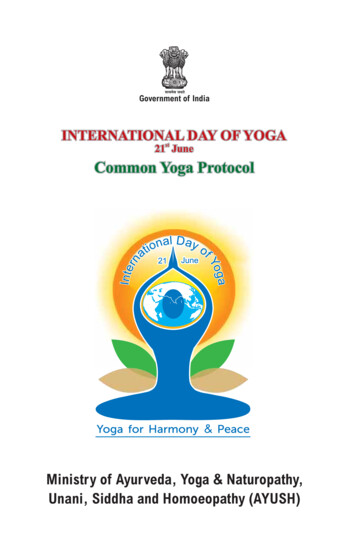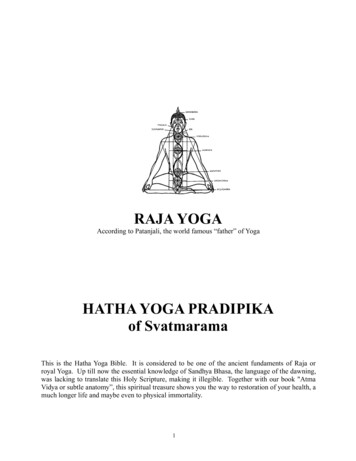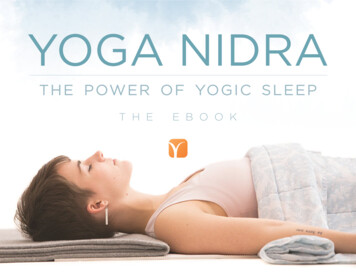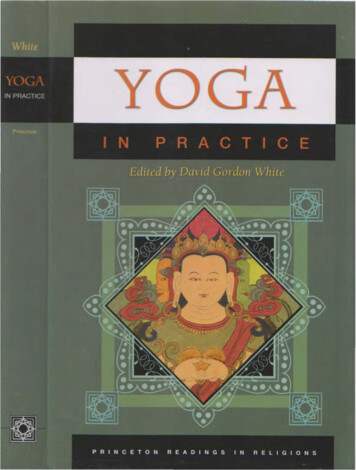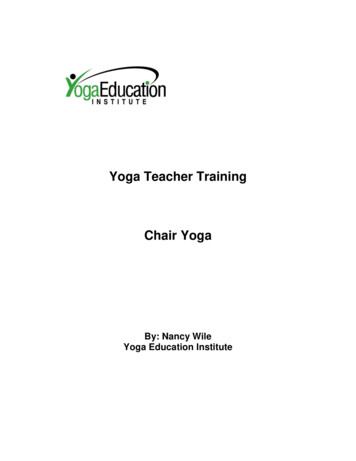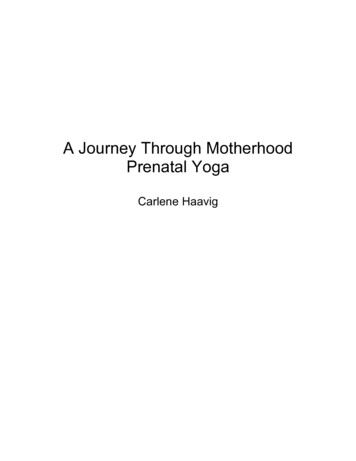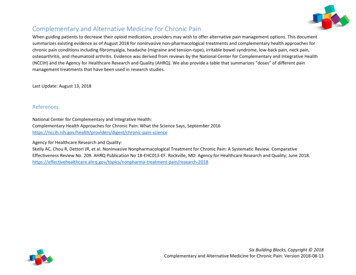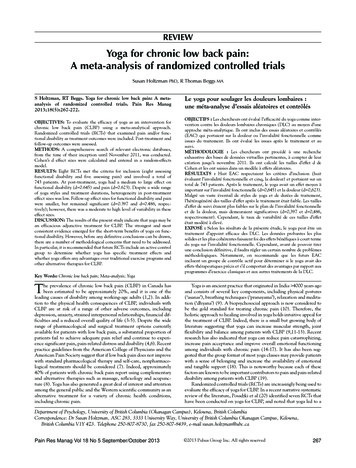
Transcription
reviewYoga for chronic low back pain:A meta-analysis of randomized controlled trialsSusan Holtzman PhD, R Thomas Beggs MAS Holtzman, RT Beggs. Yoga for chronic low back pain: A metaanalysis of randomized controlled trials. Pain Res Manag2013;18(5):267-272.OBjecTiveS: To evaluate the efficacy of yoga as an intervention forchronic low back pain (CLBP) using a meta-analytical approach.Randomized controlled trials (RCTs) that examined pain and/or functional disability as treatment outcomes were included. Post-treatment andfollow-up outcomes were assessed.MeTHOdS: A comprehensive search of relevant electronic databases,from the time of their inception until November 2011, was conducted.Cohen’s d effect sizes were calculated and entered in a random-effectsmodel.ReSulTS: Eight RCTs met the criteria for inclusion (eight assessingfunctional disability and five assessing pain) and involved a total of743 patients. At post-treatment, yoga had a medium to large effect onfunctional disability (d 0.645) and pain (d 0.623). Despite a wide rangeof yoga styles and treatment durations, heterogeneity in post-treatmenteffect sizes was low. Follow-up effect sizes for functional disability and painwere smaller, but remained significant (d 0.397 and d 0.486, respectively); however, there was a moderate to high level of variability in theseeffect sizes.diScuSSiOn: The results of the present study indicate that yoga may bean efficacious adjunctive treatment for CLBP. The strongest and mostconsistent evidence emerged for the short-term benefits of yoga on functional disability. However, before any definitive conclusions can be drawn,there are a number of methodological concerns that need to be addressed.In particular, it is recommended that future RCTs include an active controlgroup to determine whether yoga has specific treatment effects andwhether yoga offers any advantages over traditional exercise programs andother alternative therapies for CLBP.Key Words: Chronic low back pain; Meta-analysis; YogaThe prevalence of chronic low back pain (CLBP) in Canada hasbeen estimated to be approximately 20%, and it is one of theleading causes of disability among working-age adults (1,2). In addition to the physical health consequences of CLBP, individuals withCLBP are at risk of a range of other adverse outcomes, includingdepression, anxiety, strained interpersonal relationships, financial difficulties and a reduced overall quality of life (3-5). Despite the widerange of pharmacological and surgical treatment options currentlyavailable for patients with low back pain, a substantial proportion ofpatients fail to achieve adequate pain relief and continue to experience significant pain, pain-related distress and disability (4,6). Recentpractice guidelines from the American College of Physicians and theAmerican Pain Society suggest that if low back pain does not improvewith standard pharmacological therapy and self-care, nonpharmacological treatments should be considered (7). Indeed, approximately40% of patients with chronic back pain report using complementaryand alternative therapies such as massage, reflexology and acupuncture (8). Yoga has also generated a great deal of interest and attentionamong the general public and the Western scientific community as analternative treatment for a variety of chronic health conditions,including chronic pain.le yoga pour soulager les douleurs lombaires :une méta-analyse d’essais aléatoires et contrôlésOBjecTiFS : Les chercheurs ont évalué l’efficacité du yoga comme intervention contre les douleurs lombaires chroniques (DLC) au moyen d’uneapproche méta-analytique. Ils ont inclus des essais aléatoires et contrôlés(EAC) qui portaient sur la douleur ou l’invalidité fonctionnelle commeissues du traitement. Ils ont évalué les issues après le traitement et ausuivi.MÉTHOdOlOGie : Les chercheurs ont procédé à une rechercheexhaustive des bases de données virtuelles pertinentes, à compter de leurcréation jusqu’à novembre 2011. Ils ont calculé les tailles d’effet d deCohen et les ont saisies dans un modèle à effets aléatoires.RÉSulTATS : Huit EAC respectaient les critères d’inclusion (huitévaluant l’invalidité fonctionnelle et cinq, la douleur) et portaient sur untotal de 743 patients. Après le traitement, le yoga avait un effet moyen àimportant sur l’invalidité fonctionnelle (d 0,645) et la douleur (d 0,623).Malgré un vaste éventail de styles de yoga et de durées de traitement,l’hétérogénéité des tailles d’effet après le traitement était faible. Les taillesd’effet de suivi étaient plus faibles sur le plan de l’invalidité fonctionnelleet de la douleur, mais demeuraient significatives (d 0,397 et d 0,486,respectivement). Cependant, le taux de variabilité de ces tailles d’effetétait modéré à élevé.eXPOSÉ : Selon les résultats de la présente étude, le yoga peut être untraitement d’appoint efficace des DLC. Les données probantes les plussolides et les plus cohérentes faisaient foi des effets bénéfiques à court termedu yoga sur l’invalidité fonctionnelle. Cependant, avant de pouvoir tirerune conclusion définitive, il faudra régler un certain nombre de problèmesméthodologiques. Notamment, on recommande que les futurs EACincluent un groupe de contrôle actif pour déterminer si le yoga avait deseffets thérapeutiques précis et s’il comportait des avantages par rapport auxprogrammes d’exercice classiques et aux autres traitements de la DLC.Yoga is an ancient practice that originated in India 4000 years agoand consists of several key components, including physical postures(‘asanas’), breathing techniques (‘pranayama’), relaxation and meditation (‘dhyana’) (9). A biopsychosocial approach is now considered tobe the gold standard for treating chronic pain (10). Therefore, theholistic approach to healing involved in yoga holds intuitive appeal forthe treatment of CLBP. Indeed, there is a small but growing body ofliterature suggesting that yoga can increase muscular strength, jointflexibility and balance among patients with CLBP (9,11-13). Recentresearch has also indicated that yoga can reduce pain catastrophizing,increase pain acceptance and improve overall emotional functioningamong individuals with chronic pain (14-17). It has also been suggested that the group format of most yoga classes may provide patientswith a sense of belonging and increase the availability of emotionaland tangible support (18). This is noteworthy because each of thesefactors are known to be important contributors to pain and pain-relateddisability among patients with CLBP (19).Randomized controlled trials (RCTs) are increasingly being used toevaluate the efficacy of yoga for CLBP. In a recent narrative systematicreview of the literature, Posadzki et al (20) identified seven RCTs thathave been conducted on yoga for CLBP, and noted that yoga led to aDepartment of Psychology, University of British Columbia (Okanagan Campus), Kelowna, British ColumbiaCorrespondence: Dr Susan Holtzman, ASC 283, 3333 University Way, University of British Columbia Okanagan Campus, Kelowna,British Columbia V1Y 4Z3. Telephone 250-807-8730, fax 250-807-8439, e-mail susan.holtzman@ubc.caPain Res Manag Vol 18 No 5 September/October 2013 2013 Pulsus Group Inc. All rights reserved267
Holtzman and BeggsArticles initially identified(n 148)Articles excluded (n 136) for the followingreasons:Review/no original data collection/yogamentioned tangentially (n 113)Not related to both yoga and CLBP (n 15)Trial protocol only (n 2)Editorials (n 2)Conference proceedings (n 2)Case studies (n 1)Corrections (n 1)Studies selected forfurther screening (n 12)Studies (n 4) excluded for the following reasons:Intervention not successfully applied (n 1)Lacked data for analysis (n 1)Lack of a control group (n 1)Did not include an outcome measure ofinterest (n 1)Studies included in themeta-analysis (n 8)Figure 1) Study selection process. CLBP Chronic low back painsignificant reduction in pain intensity in five of these trials. Wren et al(18) reviewed six RCTs of yoga for CLBP and suggested that yogashows promise in reducing pain, pain-related disability, negative moodand pain medication among patients with CLBP. Nonetheless, onlytwo previous attempts have been made to quantify the effect sizes ofyoga on CLBP across studies. The first meta-analysis included only twosmall RCTs (21). The second included six controlled trials of yoga forback pain (total n 348), but combined these results with yoga forother conditions, such as rheumatoid arthritis, and in healthy populations without chronic pain (22). Moreover, this review did not includethe two most recent RCTs of yoga for CLBP (17,23), which are by farthe largest (n 228 and n 338) that have been conducted to date.The goal of the present study was to conduct an updatedmeta-analysis of RCTs that have evaluated the efficacy of yoga specifically for CLBP, with a focus on pain and functional disability as treatment outcomes. In addition to evaluating the robustness of previousstudy findings regarding post-treatment effects and conducting a standardized assessment of study quality, the present study is, to our knowledge, the first to include a quantitative review of the follow-uptreatment effects of yoga for CLBP. The present meta-analyticalreview and quality assessment was designed to guide future studies inthis rapidly growing area of research and to provide clinically relevantinformation for patients and clinicians regarding the immediate andfollow-up treatment effects of yoga for CLBP.MeTHOdSearch procedureThe literature search strategy involved all relevant electronic databases available through the Electronic Research Databases (eg,Cumulative Index to Nursing and Allied Health Literature, CochraneCentral Register of Controlled Trials, Embase, Global Health,MEDLINE, PsycINFO, etc) at the University of British Columbialibrary (Vancouver, British Columbia). The primary search was comprehensive, seeking articles containing the words “Yoga” and “Back”anywhere in the text of peer-reviewed journals. Searches were alsoperformed for “Yoga” and “CLBP”, “Complementary and AlternativeMedicine” and “CLBP,” and “Yoga” and “Chronic Pain” as subjectterms. The searches were performed between February 12, 2011 and268November 30, 2011, and were limited to articles that had their fullbody text written in English. Additional articles were sought by snowballing (checking the reference sections of the initial articles to identify further studies of interest). Authors who had published in this areawere also contacted to determine whether they had any informationregarding any unpublished research, but no additional manuscriptswere identified.inclusion criteriaStudies needed to meet the following inclusion criteria to be includedin the analysis: RCT; published in a peer-reviewed journal; full body text in English; yoga as a treatment for CLBP; only adult participants ( 18 years of age); reported outcome measures of pain and/or functional disability; sufficient data reported to calculate effect sizes.Study selectionA total of 148 articles were identified during the initial literaturesearch and were considered for inclusion based on study relevance andinclusion criteria. The study selection process is detailed in Figure 1.No studies were excluded due to language restrictions. Of the 12 studies that were identified as potentially suitable for the present metaanalysis, four were excluded (23-26). One of the excluded studies wasa feasibility trial designed to evaluate issues and challenges in conducting research on yoga as an intervention for CLBP (24). However,quantitative outcome data were not presented, and were not availablefrom the study authors when contacted. Groessl et al (25) conducted astudy of yoga for military veterans with CLBP, but their trial did notinclude a control group. An RCT by Tekur et al (26) evaluated theimpact of yoga on quality of life and a straight-leg raise test, but notpain or functional disability. Finally, Cox et al’s (27) pilot RCT of20 participants was excluded due to significant concerns regardingtreatment adherence. Specifically, one-half of the participants assignedto their yoga intervention did not attend any yoga classes, and themean class attendance was 1.7 (of 12 possible classes).Quality assessmentThe eight included studies (17,23,28-33) were coded for quality by RTBand a trained independent rater using the checklist to evaluate a reportof a nonparmacological trial (CLEAR NPT [34]). The CLEAR NPTwas developed using a Delphi consensus method (based on the input of55 experts, 68% of whom were members of the Cochrane collaboration)to assess the risk of bias in nonpharmacological trials. It addresses keycomponents of RCT study quality (eg, participant attrition, blinding), aswell as methodological issues unique to NPTs (eg, care provider experience or skill). The CLEAR NPT includes 10 items, as well as fivesubitems that take into consideration the fact that blinding of therapistsand participants is often not feasible in NPTs, and is accompanied by adetailed user guide. The inter-rater reliability in the current study wasgood (kappa 0.68), with agreement on 92% of the items. The mostcommon source of disagreement between raters was regarding whatqualifications were considered to be ‘adequate’ for the yoga instructors.Item discrepancies were resolved by consensus.Statistical analysisStatistical analyses were performed using SPSS version 17.0 (IBMCorporation, USA) and the meta-analysis macro available at www.spsstools.net/Syntax/MetaAnalysis . Cohen’s d was used as theestimate of the effect size (35). To take into consideration both groupand baseline differences, parametric gain scores were used wheneverpossible for the calculation of Cohen’s d. In general, d-based effectsizes can be categorized as small at the 0.20 level, medium at the0.50 level and large at the 0.80 level (36). Due to the small numberof studies included and the relative heterogeneity in study designs, aPain Res Manag Vol 18 No 5 September/October 2013
Yoga for CLBPTaBLe 1Characteristics of randomized controlled trials of yoga for adults with chronic low back painauthor (reference), yearnParticipant demographicsTreatment group (n)Control group (n)Pain outcomeFunctionaldisabilityoutcomeGalantino et al (28), 20041677% female;age range 30–65 yearsHatha yoga;6 weeks, twice per week (11)No treatment (11)Not assessedODISherman et al (29), 20056666% female;mean age 44 13 yearsViniyoga;12 weekly 75 min classes (36)Exercise (35);Bothersomeness ofself-care book (30) pain (11-point NRS)RDQWilliams et al (30), 20054468% female;mean age 48.3 1.5 yearsIyengar yoga;16 weekly 90 min classes (20)Education (24)VASPDITekur et al (31), 20088046% female;mean age 49 3.6 years (yoga),48 4 years (control)Hatha yoga and related practices; Exercise (40)8 h/day for 7 days (40)ODI (Section 1: painintensity)ODIWilliams et al (32), 20097477% female;mean age 48 yearsIyengar yoga;24 weekly 90 min classes (31)Waitlist (43)10 cm VASODISaper et al (33), 20093083% female;mean age 44 12 yearsHatha yoga;12 weekly 75 min classes (15)Waitlist (15)11-point NRSRDQSherman et al (23), 201122864% female;mean age 48.4 9.8 yearsViniyoga;12 weekly 75 min classes (92)Stretching (91);Bothersomeness ofself-care book (45) pain (11-point scale)Tilbrook et al (17), 201131368% female (yoga)/73% female(control);mean age 46.4 11.3 (yoga),46.3 11.5 (control)Yoga;Usual care (157)12 weekly 75 min classes (156)Not assessedRDQRDQNRS Numerical rating scale; ODI Oswestry Disability Index; PDI Pain Disability Index; RDS Roland-Morris Disability Questionnaire; VAS Visual analogue scalerandom-effects model was used, using Dersimonian-Laird’s method(37). Random-effects models do not presume that there is only onetrue effect size; rather, they allow for variance in methodologies andeffect sizes between studies (38). Both post-treatment and follow-upeffect sizes were calculated. For the post-treatment analyses, the earliest assessment of the outcome variables after treatment was used.For the follow-up analyses, the assessment closest to three monthspostintervention was used. Values from intention-to-treat analyseswere used when available. Because methodological variance amongstudies can cause difficulties in the interpretation of the results ofa meta-analysis, and because the majority of the RCTs included inthe present meta-analysis used a waitlist or education control group,outcome data provided for the waitlist or education control groupswere used when multiple control groups were included. Therefore,although Sherman et al (23,29) used a self-care education andexercise/stretching control group in their trials, only the data fromthe self-care control group were included. For the same reason, resultsfrom the 10 cm visual analogue scale (VAS) in Williams et al (30)were used, rather than results from the present pain intensity scale(which assesses pain from 0 to 5 and was not used in any of the otherstudies). The VAS results provided a more conservative estimate ofthe effects found in Williams et al (30) compared with the presentpain intensity results.Orwin’s (39) fail-safe n was calculated to determine the number ofstudies with an effect size of zero that would be required to reduce theeffect size of yoga to 0.20. The fail-safe n is derived using the following formula: [n(d – dc)]/dc. In this formula, n is the number of studiesin the meta-analysis, d is the mean effect size across the n studies, anddc is the criterion effect size to which d would drop (in this case,0.20). Two statistical tests of the degree of heterogeneity were used:Cochrane’s Q (based on the χ2 test) and the I2 statistic (40,41).Cochrane’s Q tests the null hypothesis that the included studies sharea common effect size. The I2 statistic is an indication of the amountof variance among studies resulting from heterogeneity rather thanchance. It represents heterogeneity as a percentage between 0 and100, with general guidelines indicating that 25% represents low, 50%represents moderate and 75% represents high heterogeneity (40).Due to the small number of studies included in the present metaanalysis, it was not possible to statistically examine sources ofheterogeneity.Pain Res Manag Vol 18 No 5 September/October 2013ReSulTSAn overview of the study characteristics is provided in Table 1. Studyparticipants were predominantly middle-age Caucasian women. Sevenof the eight trials were conducted in the United States (17,23,2830,32,33) and one trial was conducted in India (31). Studies ranged insize from 16 (28) to 313 (17) participants. The styles of yoga included:Hatha (n 3; a general term denoting a focus on physical postures)(28,31,33); Iyengar (n 2; a style of Hatha yoga that focuses on precision and alignment with extensive use of props) (30,32); Viniyoga(n 2; yoga involving an individually tailored sequences of poses)(23,29); and an unspecified type (n 1) (17). Control groups includedin the analyses were education (n 3) (29,30), exercise (n 1) (31),waitlist control (n 2) (32,33) and usual care (n 2) (17,28). Six of theeight trials reported on session attendance, and attendance appearedto be quite high overall. In three trials (each consisting of 12 yoga sessions), the median session attendance was eight (33), nine (29) and 10(23) sessions. In both of the trials by Williams et al (30,32), participants attended approximately 90% of the yoga sessions. Another studyreported that 60% of participants attended at least six of 12 yoga sessions (17). Regular home practice was encouraged across trials, but therecommended frequency and duration of home practice varied.Similarly, most studies assessed home practice, but adherence to homework log completion was inconsistent and adherence to home practicevaried substantially within and across studies.Pain and functional disability were assessed using scales that havegenerally demonstrated strong reliability and validity in past research.Pain was assessed in six trials, using either a VAS of pain intensity(42), a numerical rating scale of pain intensity (43), the pain intensitysubscale of the Oswestry Disability Index (44) or a numerical ratingscale of pain bothersomeness (23,29). Measures of functional disabilityincluded the Oswestry Disability Index (44), the Roland-MorrisDisability Scale (45) and the Pain Disability Index (46).Summaries of the study findings, including individual and overalleffect sizes, are presented in Table 2 (post-treatment results) andTable 3 (follow-up results). Of note, no serious adverse events werereported across studies. Minor adverse events (eg, increased pain) wererare. Of the 401 patients who were randomized to a yoga treatmentgroup across the included studies, nine experienced an increase in painthat was “definitely” (n 2), “probably or definitely” (n 3), or “probably or possibly” (n 4) attributable to yoga.269
Holtzman and BeggsTaBLe 2Post-treatment effect sizes of yoga for the treatment ofchronic low back painauthor (reference), yearnPain(Cohen’s d)TaBLe 3Follow-up treatment effect sizes of yoga for the treatmentof chronic low back painFunctional disability(Cohen’s d)Follow-up(number ofFunctionalweeks postPaindisabilitytreatment) (Cohen’s d) (Cohen’s d)Galantino et al (28), 200422n/a0.49Sherman et al (29), 200566n/a0.85author (reference), yearn0.40Sherman et al (29), 200566141.160.9042120.480.35Williams et al (30), 2005440.38Tekur et al (31), 2008800.271.01Williams et al (30), 2005Williams et al (32), 2009900.870.82Williams et al (32), 200990240.720.81Saper et al (33), 2009300.900.34Saper et al (33), 20093014 0.84 0.37Sherman et al (23), 20111370.740.62Sherman et al (23), 2011 137140.420.4824n/a0.41n/a0.55Tilbrook et al (17), 2011Total n381743Total n365637Cohen’s d0.6230.645Cohen’s d0.3970.48618Orwin’s fail-safe n59Tilbrook et al (17), 2011Orwin’s fail-safe n27411n/a Not availablen/a Not availableQuality assessmentThe two most recent trials of yoga for CLBP satisfied all criteria outlined by the CLEAR NPT, with the exception of items regarding theblinding of therapists and participants (which was not feasible) (17,23).Two of the eight trials included in the present meta-analysis failed touse an intention-to-treat analysis (30,31). Three trials were unclearwith respect to the concealment of treatment allocation (28,30,32)and two trials were unclear regarding the use of skilled yoga therapists(29,31). No RCT included in the present meta-analysis received a ‘no’or ‘unclear’ on more than four of the possible 15 CLEAR NPT itemsand subitems. The most common weakness among the studies was thefailure to adequately blind study participants and therapists, which wasnot feasible in the context of these yoga trials.efficacy of yoga for painThe overall post-treatment effect size of yoga on pain was d 0.623(95% CI 0.377 to 0.868; n 5), indicating a medium to large effect size(36). Orwin’s fail-safe n was 11, indicating that 11 studies with nonsignificant results would have to have been missed for the treatmenteffect of yoga on pain to be reduced to a small effect size of 0.2. The χ2of heterogeneity test was nonsignificant (χ2 5.16, df 4; P 0.27), andthe I2 statistic was 22.4%, indicating low variation in effect sizesamong studies.Compared with the post-treatment results, analysis of the follow-updata revealed a smaller effect size of d 0.397 (95% CI 0.053 to 0.848;n 5). Orwin’s fail-safe n was five. The degree of heterogeneity wassignificant (χ2 15.86, df 4; P 0.003), and the I2 statistic was 74.8%,indicating a high level of variability across studies.efficacy of yoga for functional disabilityThe overall post-treatment effect size of yoga on functional disabilitywas d 0.645 (95% CI 0.496 to 0.795; n 8), indicating a medium tolarge effect size (36). Orwin’s fail-safe n was 18. The χ2 of heterogeneity test was nonsignificant (χ2 5.75, df 7; P 0.569), indicating therewas no significant variation in the effect sizes among the includedstudies on this outcome measure. The I2 and Tau-square were bothzero, indicating that a fixed-effect model would have yielded the sameresult for this analysis, and that there was limited variability amongstudies.Analysis of the follow-up data for functional disability revealed amedium effect size of d 0.486, (95% CI 0.226 to 0.746; n 6). Orwin’sfail-safe n was nine. The heterogeneity of the included studies washigher than the post-treatment data, with a χ2 that was close to statistical significance (χ2 10.67, df 5; P 0.058), and an I2 of 53.1% (inthe moderate range).diScuSSiOnOver the past several years, there has been a dramatic surge of interestamong the Western scientific community regarding the possible270272health benefits of yoga for chronic pain, with a particular interest in itsrole in treating CLBP. To evaluate the efficacy of yoga as a treatmentfor CLBP, the present meta-analysis examined the post-treatment andfollow-up results of eight RCTs that included a total of 743 patients.By limiting our review to only RCTs, our results provide a reliable, yetconservative, estimate of the efficacy of yoga for CLBP. The posttreatment effect sizes of yoga for pain and functional disability wereboth in the medium-to-large range (d 0.623 and d 0.645, respectively). At follow-up, effects were smaller, but still significant, witheffect sizes in the small to medium range for pain and disability(d 0.397 and d 0.486, respectively). These findings are particularlyencouraging given that CLBP is a highly prevalent and disabling condition that has historically been difficult to treat (46).The results of our meta-analysis are also consistent with the moderate post-treatment effect sizes found in a recent meta-analysis byBussing et al (22). However, in contrast to the moderate degree ofheterogeneity identified by Bussing et al (22), we found low heterogeneity in the effect sizes for pain and disability. This difference islikely largely due to the fact that our analyses focused only on CLBPpatients, and only on RCTs. Given that these differences (combinedwith a more than double-sized sample and two additional high-qualitystudies) led to lower effect-size variability in our study, we can furtherincrease our confidence that yoga may represent an efficaciousadjunctive treatment for CLBP. Compared with the results of metaanalyses of other popular nonpharmacological interventions for CLBP(47), we can also state that the effect size for yoga in reducing pain andfunctional disability appears to be similar to, if not higher than, effectssizes for more traditional exercise therapy (48), cognitive behaviouraltherapy (49) and acupuncture (50).Overall, our findings provide the strongest support for the effects ofyoga on short-term improvements in functional disability amongpatients with CLBP. Based on a total of eight RCTs, the moderate posttreatment effect size was a robust finding, with a fail-safe n of 18 and nosignificant heterogeneity across studies. It is interesting to note that arange of different yoga interventions yielded statistically similar effectsizes. Of the eight RCTs, three reported using Hatha yoga, two usedIyengar yoga, two used Viniyoga and one used an unspecified type ofyoga. This suggests that yoga’s general emphasis on strength, flexibility,breathing and focused awareness may be more important than thespecific sequence or type of yoga postures (‘asanas’) used in differentstyles of yoga. However, the fact that one-half of the RCTs used a waitlist control group raises two important issues. First, without an activetreatment control, one cannot rule out the possibility that the benefitsof yoga were due (at least in part) to nonspecific treatment effects, suchas extra attention, teacher enthusiasm and positive treatment expectations. Second, treatment gains may be attributable to the already established general benefits of physical activity for CLBP, and not specificallyPain Res Manag Vol 18 No 5 September/October 2013
Yoga for CLBPdue to the effects of yoga (7,48). Although Tekur et al (31) found yogato be superior to “physical movements” and nonyogic breathing exercises on both pain and disability outcomes, they did not indicate thespecific nature of these physical movements. Sherman et al’s (29) firstRCT of yoga for CLBP found that yoga led to statistically greater posttreatment improvements in functional status compared with a traditional exercise group (involving stretching, aerobic and strengtheningexercises). However, this effect was not clinically significant and theeffect dropped to a trend level of statistical significance by 14 weekspostintervention. Sherman et al’s (23) more recent RCT compared yogawith stretching (and a small number of strengthening exercises) andfailed to detect any significant differences in pain bothersomeness ordisability between yoga and stretching groups at any timepoint. Thesemixed findings suggest a need for further research that compares theefficacy of yoga with other forms of physical activity, including traditional exercise programs and alternative therapeutic approaches (eg,pilates, tai chi).The present study was, to our knowledge, the first to quantify thefollow-up treatment effects of yoga for CLBP across previous RCTs.Based on the six RCTs that provided follow-up data (at three or sixmonths), evidence for the longer-term benefits of yoga on pain anddisability is promising, but the magnitude of treatment gains appears tobe smaller and more heterogeneous than the post-treatment effects.Five of six RCTs demonstrated that treatment gains can persist forseveral months beyond the formal intervention period. In contrast,one RCT found that pain and disability actually worsened in the yogagroup compared with the waitlist control group during the follow-upperiod (31). This was attributed to the fact that more than one-half ofthe yoga group (eight of the 15 participants) was lost to follow-up andone-third of the control group began practicing yoga
American Pain Society suggest that if low back pain does not improve with standard pharmacological therapy and self-care, nonpharmaco-logical treatments should be considered (7). Indeed, approximately 40% of patients with chronic back pain report using complementary and alternative therapies such as massage, reflexology and acupunc-ture (8).
